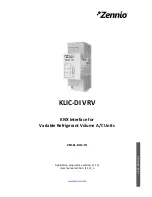
ENGINEERING MANUAL OF AUTOMATIC CONTROL
CHILLER, BOILER, AND DISTRIBUTION SYSTEM CONTROL APPLICATIONS
375
HIGH TEMPERATURE WATER SAFETY
A well designed HTW system with proper installation of
piping to prevent undue stress rarely fails.
HTW drops in temperature very rapidly with a minor, low
mass, flow leak into space. In low or medium temperature water
the escaping fluid remains at nearly the same temperature. HTW
flashes to steam and the turbulent mixing of liquid and vapor
with the room air rapidly drops the fluid temperature below
100
°
C and within a short distance to 52 to 60
°
C.
Minor leakage at valves is usually imperceptible except for
deposits of scale at the point of leakage. Valves should be
inspected periodically and scale removed from valve stems to
prevent damage to packing and to allow free valve movement.
HTW CONTROL SELECTION
The features of good temperature control for low and medium
temperature water heating systems also apply to high
temperature water heating. Special considerations are needed
for controls to withstand the temperatures and pressures
encountered in a HTW system. The large temperature difference
between HTW and the heated fluid (air, water, or steam) means
that most of the control selection precautions are to provide
fail safe operation. Careful consideration must be given to what
happens to the secondary fluid of a converter and its controls
when flow is reduced or stopped, or equipment is shutdown.
Secondary fluid can overheat immediately after or during
prolonged shutdown. Controls near a HTW supplied coil can
be damaged by high temperature if airflow stops.
Controls can be pneumatic, electric, or digital. The low mass
of electronic temperature sensors (thermocouple or resistance
bulb) provides faster response than fluid-filled or bimetal
elements. Pneumatic actuators generally have the faster
response, higher temperature ratings, and greater reliability
required for HTW applications.
Standard commercial quality controls with integral
(automatic reset) and derivative (rate) action are satisfactory
for most applications when used with industrial quality valves.
An industrial controller or a digital system may be required
where local recording of a control value is specified. The control
system selected should:
1. Function from zero to full load.
2. Close the HTW valve if there is failure in the control
system, loss of power or air, or shutdown of the system
being controlled.
HTW VALVE SELECTION
Valves for HTW must be selected to ensure suitability for
high temperature and pressure conditions. A control valve must
have wide rangeability (50 to 1 is desirable) and the ability to
position accurately and hold that position. Rangeability is the
ratio of maximum flow for a valve to the minimum controllable
flow. These requirements dictate use of industrial quality valves.
For additional information on rangeability see the Valve
Selection and Sizing section.
VALVE STYLE
Single seated valves are recommended because of their tight
shut-off and availability with equal percentage and reduced
capacity (Kv) trim.
Double seated valves are not recommended because they do
not provide tight shut off. High velocity leakage past the plug
of a double-seated valve causes greater erosion to the seats than
a single-seated valve.
Three-way valves are not recommended because they are not
available with equal percentage flow characteristics and
therefore do not provide the required control stability. They
also are not available with reduced Kv trim for accurate sizing.
Valve bodies should be flanged although threaded bodies can
be used for sizes of ISO 32 mm or less. Weeping and flashing
at threads is likely but usually not visible except for deposits
left behind. If threaded valves are used in the HTW lines, use
adjacent bolted flanges not union fittings.
VALVE BODY MATERIALS
Cast steel bodies with 2000 kPa or 4000 kPa body ratings
are recommended. These have temperature ratings above
400
°
C, the limit for packing materials. Manufacturers literature
lists actual pressure and temperature ratings.
Bronze bodies are not recommended because the maximum
temperature limit is 200
°
C. In addition, since HTW piping is
steel, galvanic action between bronze and steel can be serious
at the elevated temperatures encountered.
Cast iron bodies are not recommended because maximum
operating conditions are limited to 208
°
C at 1700 kPa, which
are too close to operating conditions.
Summary of Contents for AUTOMATIC CONTROL SI Edition
Page 1: ...AUTOMATIC CONTROL for ENGINEERING MANUAL of COMMERCIAL BUILDINGS SI Edition ...
Page 4: ...ENGINEERING MANUAL OF AUTOMATIC CONTROL iv ...
Page 6: ...ENGINEERING MANUAL OF AUTOMATIC CONTROL vi ...
Page 46: ...ENGINEERING MANUAL OF AUTOMATIC CONTROL CONTROL FUNDAMENTALS 36 ...
Page 66: ...ENGINEERING MANUAL OF AUTOMATIC CONTROL PSYCHROMETRIC CHART FUNDAMENTALS 56 ...
Page 128: ...ENGINEERING MANUAL OF AUTOMATIC CONTROL ELECTRIC CONTROL FUNDAMENTALS 118 ...
Page 158: ...MICROPROCESSOR BASED DDC FUNDAMENTALS 148 ENGINEERING MANUAL OF AUTOMATIC CONTROL ...
Page 208: ...ENGINEERING MANUAL OF AUTOMATIC CONTROL BUILDING MANAGEMENT SYSTEM FUNDAMENTALS 198 ...
Page 493: ...INDEX ENGINEERING MANUAL OF AUTOMATIC CONTROL 483 INDEX ...
Page 506: ...ENGINEERING MANUAL OF AUTOMATIC CONTROL INDEX 496 NOTES ...
Page 507: ...INDEX ENGINEERING MANUAL OF AUTOMATIC CONTROL 497 NOTES ...
Page 508: ...ENGINEERING MANUAL OF AUTOMATIC CONTROL INDEX 498 NOTES ...
Page 509: ...INDEX ENGINEERING MANUAL OF AUTOMATIC CONTROL 499 NOTES ...
Page 510: ...ENGINEERING MANUAL OF AUTOMATIC CONTROL INDEX 500 NOTES ...
Page 511: ...INDEX ENGINEERING MANUAL OF AUTOMATIC CONTROL 501 NOTES ...
Page 512: ...ENGINEERING MANUAL OF AUTOMATIC CONTROL INDEX 502 NOTES ...
















































